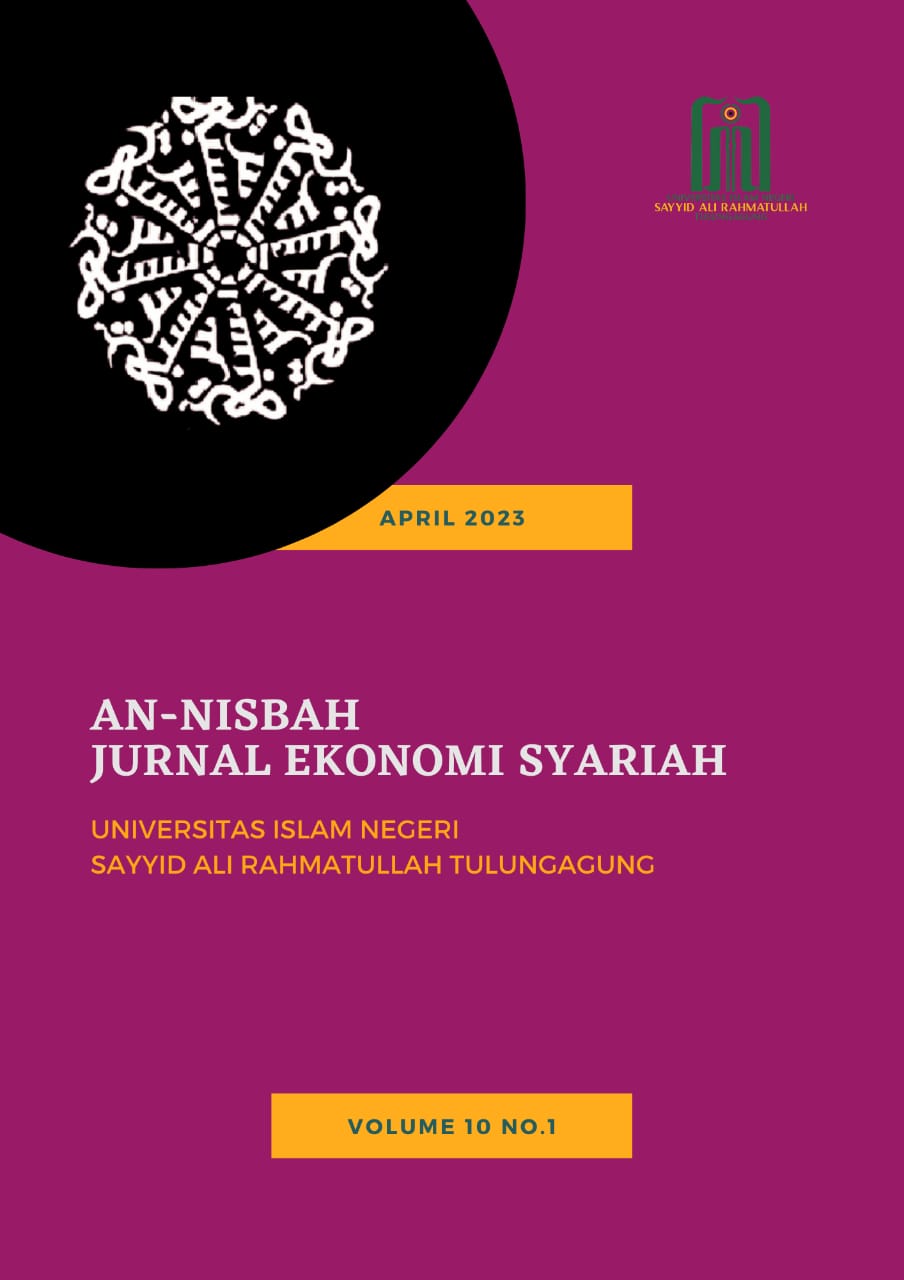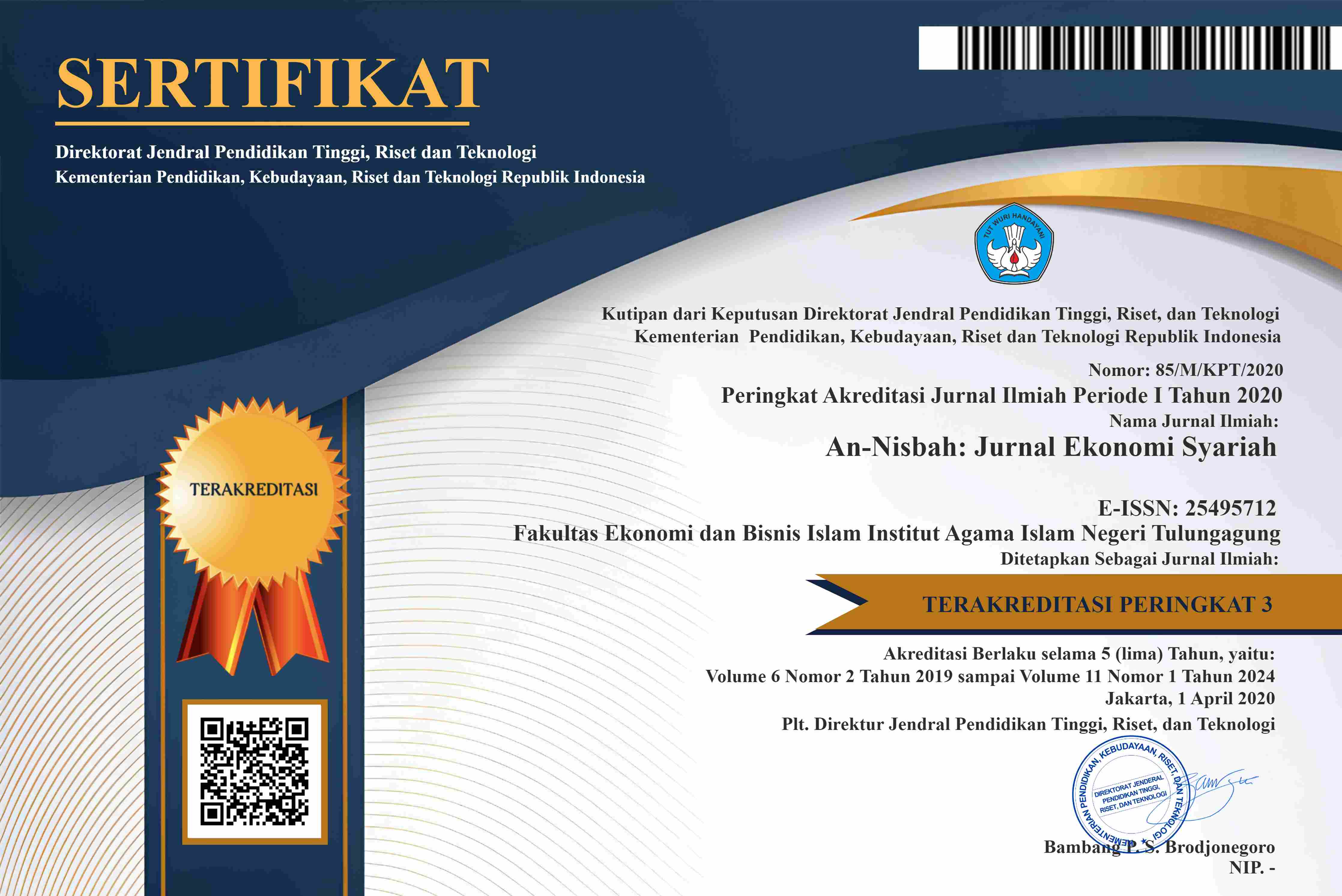MILLENIAL GENERATION SHOPPING BEHAVIOR IN BUYING IMPORTED HALAL LABELED FOOD PRODUCTS IN INDONESIA
Abstract
Abstrak: Penelitian ini bertujuan untuk menganalisis perilaku belanja generasi Milenial terhadap pembelian makanan impor berlabel halal. Penelitian ini menjadi penting mengingat maraknya produk multinasional yang mulai mendominasi pasar Indonesia, khususnya produk makanan halal. Metode yang digunakan adalah pendekatan kuantitatif dengan data primer dan sekunder. Teknik pengumpulan data yang digunakan adalah purposive sampling, sedangkan teknik analisis data yang digunakan adalah Structural Equation Modeling-Partial Least Square (SEM-PLS). Variabel yang digunakan dalam penelitian ini adalah citra merek, kesadaran halal, harga, niat beli, dan perilaku pembelian. Hasil penelitian menunjukkan bahwa citra merek berpengaruh terhadap perilaku pembelian, citra berpengaruh terhadap niat beli, kesadaran halal berpengaruh terhadap niat beli, harga berpengaruh terhadap perilaku beli, dan harga berpengaruh terhadap niat beli, sedangkan penelitian niat beli tidak berpengaruh terhadap perilaku beli. Hasil penelitian ini menunjukkan bahwa kesadaran halal, harga dan citra dapat mempengaruhi perilaku konsumen milenial dalam membeli produk penting berlabel halal. Selain itu, hasil ini akan memberikan kontribusi kepada pemerintah sebagai pembuat kebijakan untuk membatasi impor produk luar negeri yang masuk ke Indonesia, yang tentunya akan membuat produk dalam negeri kalah bersaing dengan produk impor.
Kata kunci: Generasi Milenial; Makanan Impor Berlabel Halal; SEM-PLS.
Abstract: This study aims to analyze the shopping behavior of the Millennial generation towards purchases imported food labeled halal. This research is important due to the increasment of multinational product which start to dominating Indonesian market, especially halal food products. The method used is quantitative approach with primary and secondary data. Purposive sampling is utilized for data collecting, and structural equation modeling-partial least squares is employed for data processing (SEM-PLS). Brand image, halal awareness, pricing, purchase intention, and purchasing behavior are the variables used in this study. The findings revealed that brand image affects purchase intention, image affects purchase behavior, halal knowledge affects purchase intention, pricing affects both buying behavior and purchase intention, and study on purchase intention has little impact on actual purchasing. The result of this study indicate that halal awareness, price and image can influence millennial customers behavior of buying important products labeled halal. In addition, this result will contribute to the government as the policy maker to limit imports of foreign products Entering Indonesia, which of course will make domestic products less competitive with imported products
Keywords: Milennial Generation; Imported Food Labelled Halal; SEM-PLS.
Downloads
References
Akroush, Mamoun N., Luai E. Jraisat, Dina J. Kurdieh, Ruba N. AL-Faouri, and Laila T. Qatu. “Tourism Service Quality and Destination Loyalty – the Mediating Role of Destination Image from International Tourists’ Perspectives.” Tourism Review 71, no. 1 (2016): 18–44.
Al-Salamin, H, E Al-Hassan - European Journal of Business and, and undefined 2016. “The Impact of Pricing on Consumer Buying Behavior in Saudi Arabia: Al-Hassa Case Study.” researchgate.net (n.d.). Accessed January 24, 2021. https://www.researchgate.net/profile/Hussain_Al-Salamin/publication/301753990_The_Impact_of_Pricing_on_Consumer_Buying_Behavior_in_Saudi_Arabia_Al-Hassa_Case_Study/links/5725bf9308aee491cb3aa505.pdf.
Alvarez, Begoa Alvarez, and Rodolfo Vázquez Casielles. “Consumer Evaluations of Sales Promotion: The Effect on Brand Choice.” European Journal of Marketing 39, no. 1–2 (2005): 54–70.
Amalia, Fatya Alty, Adila Sosianika, and Dwi Suhartanto. “Indonesian Millennials’ Halal Food Purchasing: Merely a Habit?” British Food Journal 122, no. 4 (2020): 1185–1198.
Asshidin, Nor Hazlin Nor, Nurazariah Abidin, and Hafizzah Bashira Borhan. “Perceived Quality and Emotional Value That Influence Consumer’s Purchase Intention towards American and Local Products.” Procedia Economics and Finance 35, no. October 2015 (2016): 639–643. http://dx.doi.org/10.1016/S2212-5671(16)00078-2.
Aziz, Yuhanis Abdul, and Nyen Vui Chok. “The Role of Halal Awareness, Halal Certification, and Marketing Components in Determining Halal Purchase Intention Among Non-Muslims in Malaysia: A Structural Equation Modeling Approach.” Journal of International Food and Agribusiness Marketing 25, no. 1 (2013): 1–23.
Bashir, Abdalla M., Abdullah Bayat, Samuel Oladipo Olutuase, and Zul Ariff Abdul Latiff. “Factors Affecting Consumers’ Intention towards Purchasing Halal Food in South Africa: A Structural Equation Modelling.” Journal of Food Products Marketing 25, no. 1 (2019): 26–48. https://doi.org/10.1080/10454446.2018.1452813.
Beneke, J, R Flynn, T Greig, M Mukaiwa - Journal of Product & Brand, and undefined 2013. “The Influence of Perceived Product Quality, Relative Price and Risk on Customer Value and Willingness to Buy: A Study of Private Label Merchandise.” emerald.com (n.d.). Accessed January 24, 2021. https://www.emerald.com/insight/content/doi/10.1108/JPBM-02-2013-0262/full/html?casa_token=4Mdw4zWwL88AAAAA:X1YWK-Y-1t_dFOgB0X3xaeVqNISrO0IkYzvfLlgmaGmHstAtLVYgtyCLmM4j1Nedy5owHiEayDkHxsr-dk2HoxHyUtCGKg797N3e5umrj_754Om0Ow.
Bian, Xuemei, and Luiz Moutinho. “The Role of Brand Image, Product Involvement, and Knowledge in Explaining Consumer Purchase Behaviour of Counterfeits: Direct and Indirect Effects.” European Journal of Marketing 45, no. 1 (2011): 191–216.
Bucic, Tania, Jennifer Harris, and Denni Arli. “Ethical Consumers Among the Millennials: A Cross-National Study.” Journal of Business Ethics 110, no. 1 (2012): 113–131.
Crosno, Freling, & Skinner. “Understanding the Acceptance of Mobile SMS Advertising among Young Chinese Consumers.” Psychology & Marketing 30, no. 6 (2010): 461–469. http://eprints.lancs.ac.uk/23431/.
DelVecchio, Devon, H. Shanker Krishnan, and Daniel C. Smith. “Cents or Percent? The Effects of Promotion Framing on Price Expectations and Choice.” Journal of Marketing 71, no. 3 (2007): 158–170.
Dinar Standard. State of the Global Islamic Economy Report. Dubai, 2018.
———. State of the Global Islamic Economy Report. Dubai, 2020.
Haliza, S. N., & Habib, M. A. F. (2022). Analisis Perilaku Konsumerisme Masyarakat pada Diskon Belanja Online Pengguna E-Commerce Shopee. Jurnal Sosiologi Dialektika Sosial, 8(2), 85-101.
Huck, Steffen, and Brian Wallace. The Impact of Price Frames on Consumer Decision Making: Experimental Evidence. Ucl.Ac.Uk, 2015. Accessed January 24, 2021. https://www.ucl.ac.uk/~uctpbwa/papers/price-framing.pdf.
Jeong, Eun Ha, Soo Cheong Jang, Jonathon Day, and Sejin Ha. “The Impact of Eco-Friendly Practices on Green Image and Customer Attitudes: An Investigation in a Café Setting.” International Journal of Hospitality Management 41 (2014): 10–20. http://dx.doi.org/10.1016/j.ijhm.2014.03.002.
Komite Nasional Keuangan Syariah. Masterplan Ekonomi Syariah Indonesia 2019-2024. Kementerian Perencanaan Pembangunan Nasional/ Badan Perencanaan Pembangunan Nasional, 2018. https://knks.go.id/storage/upload/1573459280-Masterplan Eksyar_Preview.pdf.
Kotler, Amstrong. “Prinsip-Prinsip Pemasaran, Edisi Keduabelas, Jilid 1.” Erlangga. Last modified 2001. Accessed September 28, 2020. http://kundang.weblog.esaunggul.ac.id/wp-content/uploads/sites/99/2016/03/MATERI-4-KUL-ONLINE2016.pdf.
Lee, Jihyun, and Yuri Lee. “Effects of Multi-Brand Company’s CSR Activities on Purchase Intention through a Mediating Role of Corporate Image and Brand Image.” Journal of Fashion Marketing and Management 22, no. 3 (2018): 387–403.
Lissitsa, Sabina, and Ofrit Kol. “Generation X vs. Generation Y - A Decade of Online Shopping.” Journal of Retailing and Consumer Services 31 (2016): 304–312. http://dx.doi.org/10.1016/j.jretconser.2016.04.015.
Marmaya, N. H., Za Zakaria, and Mohd Nasir Mohd Desa. “Gen Y Consumers’ Intention to Purchase Halal Food in Malaysia: A PLS-SEM Approach.” Journal of Islamic Marketing 10, no. 3 (2019): 1003–1014.
De Matos, Celso Augusto, Cristiana Trindade Ituassu, and Carlos Alberto Vargas Rossi. “Consumer Attitudes toward Counterfeits: A Review and Extension.” Journal of Consumer Marketing 24, no. 1 (2007): 36–47.
Mohamed Omar, Khairi, Nik Kamariah Nik Mat, Gaboul Ahmed Imhemed, and Fatihya Mahdi Ahamed Ali. “The Direct Effects of Halal Product Actual Purchase Antecedents among the International Muslim Consumers.” American Journal of Economics 2, no. 4 (2012): 87–92.
Mohd Suki, Norazah, and Abang Sulaiman Abang Salleh. “Does Halal Image Strengthen Consumer Intention to Patronize Halal Stores?: Some Insights from Malaysia.” Journal of Islamic Marketing 7, no. 1 (2016): 120–132.
Mulyana, Mumuh. “Strategi Penetapan Harga.” Universitas Terbuka. Last modified 2019. Accessed September 27, 2020. https://www.researchgate.net/publication/333719147_Strategi_Penetapan_Harga.
Mutmainah, Lu’liyatul. “The Role of Religiosity, Halal Awareness, Halal Certification, and Food Ingredients on Purchase Intention of Halal Food.” Ihtifaz: Journal of Islamic Economics, Finance, and Banking 1, no. 1 (2018): 33.
Nalebuff, Ian Ayres and Barry. “MITSloan Management Review In Praise of Honest Pricing.” Contraria. Last modified 2003. Accessed September 30, 2020. http://spinup-000d1a-wp-offload-media.s3.amazonaws.com/faculty/wp-content/uploads/sites/8/2019/06/InPraiseHonestPricing_Sloan2003.pdf.
Pew Research Center. “Global Religious Futures.” Pewforum.Org. Last modified 2020. Accessed September 27, 2020. http://www.globalreligiousfutures.org/countries/indonesia/religious_demography#/?affiliations_religion_id=0&affiliations_year=2010.
Putra, Yanuar Surya. “THEORITICAL REVIEW : TEORI PERBEDAAN GENERASI.” Among Makarti 9, no. 18 (2016): 123–134.
Rita. “Brand Image.” Binus.Ac.Id. Last modified 2018. Accessed September 27, 2020. https://bbs.binus.ac.id/gbm/2018/03/27/brand-image/.
Rizwan, Muhammad, Muhammad Imran, Ahsan Qayyum, M Yousaf, Sobia Afzal, and Noreen Fatima. “Cons Umer ’ s Purchase Intention towards Counterfeit Mobile Phones” (2009): 36–43.
Shah Alam, Syed, and Nazura Mohamed Sayuti. “Applying the Theory of Planned Behavior (TPB) in Halal Food Purchasing.” International Journal of Commerce and Management 21, no. 1 (2011): 8–20.
Shidiqy, D., & Setiawan, R. (2022). Dominasi Brand Minded dan Multi-Brand Loyalty dalam Pembelian Produk Dengan Luxury Brand. Jurnal Penelitian Mahasiswa Ilmu Sosial, Ekonomi, dan Bisnis Islam (SOSEBI), 2(1), 123-136. https://doi.org/10.21274/sosebi.v2i1.5352
Sparks, Beverley A., and Victoria Browning. “The Impact of Online Reviews on Hotel Booking Intentions and Perception of Trust.” Tourism Management 32, no. 6 (December 1, 2011): 1310–1323.
Stevina, Elisabeth, and Ritzky Karina M.R. Brahmana. “Pengaruh Brand Identity Terhadap Purchase Intention Melalui Trust Di UD. Makin Hasil Jember.” Jurnal Strategi Pemasaran 3, no. 1 (2015): 1–8. http://publication.petra.ac.id/index.php/manajemen-pemasaran/article/view/3359.
Sultan, Parves, and Ho Yin Wong. “How Service Quality Affects University Brand Performance, University Brand Image and Behavioural Intention: The Mediating Effects of Satisfaction and Trust and Moderating Roles of Gender and Study Mode.” Journal of Brand Management 26, no. 3 (2019): 332–347. https://doi.org/10.1057/s41262-018-0131-3.
Varinli, İnci, Ekrem Erdem, Yüksel Mutlu, Yuksel Avcılar, and Mutlu Yüksel Avcılar. “Exploring the Factors Affecting Purchase Intention of Halal Certified Foods in Turkey: A PLS-Path Modeling Study.” European Journal of Business and Management 8, no. 4 (2016): 2222–2839. https://www.researchgate.net/publication/296700568_Exploring_the_Factors_Affecting_Purchase_Intention_of_Halal_Certified_Foods_in_Turkey_A_PLSPath_….
Xia, Lan, Kent B Monroe, Jennifer L Cox, ) Kent, B Monroe, and J M Jones. The Price Is Unfair! A Conceptual Framework of Price Fairness Perceptions. Price Fairness Perceptions / 1 Journal of Marketing. Vol. 68, 2004.
Zakaria, Z, M.D. Abdul Majid, Z Ahmad, Z Jusoh, and N.Z. Zakaria. “Influence of Halal Certification on Customers’ Purchase Intention.” Journal of Fundamental and Applied Sciences 9, no. 5S (2018): 772.
The author has full rights to the articles that has been sent to An-Nisbah: Jurnal Ekonomi Syariah. The author is responsible for the originality of the articles and all the references used in the journal script.








